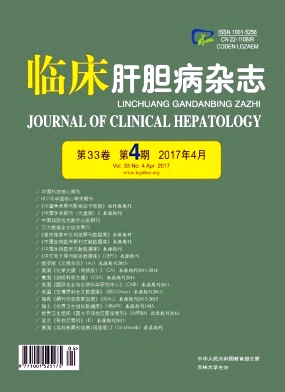|
[1]LI C, LIU HL, ZANG H, et al.Expression of myeloid-derived suppressor cells in peripheral blood in patients with HBV-related acute-on-chronic liver failure[J].Infect Dis Info, 2013, 26 (6) :343-347. (in Chinese) 李晨, 刘鸿凌, 臧红, 等.外周血髓源性抑制细胞在HBV相关慢加急性肝衰竭患者中表达的研究[J].传染病信息, 2013, 26 (6) :343-347.
|
|
[2]ZHANG L, BAI H, LI XC, et al.Early diagnosis and prognosis prevision for patients of spontaneous bacterial peritonitis[J].J China Med Univ, 2008, 37 (1) :109-111. (in Chinese) 张琳, 白菡, 李向春, 等.自发性细菌性腹膜炎患者的临床早期诊断及预后判定[J].中国医科大学学报, 2008, 37 (1) :109-111.
|
|
[3] WEI CX, GONG HY.Advances in the diagnosis of spontaneous bacterial peritonitis[J].Med Inf, 2013, 26 (1) :317-318. (in Chinese) 魏超霞, 龚环宇.自发性细菌性腹膜炎的诊断进展[J].医学信息, 2013, 26 (1) :317-318.
|
|
[4]Liver Failure and Artificial Liver Group, Chinese Society of Infectious Diseases, Chinese Medical Association;Severe Liver Diseases and Artificial Liver Group, Chinese Society of Hepatology, Chinese Medical Association.Diagnostic and treatment guidelines for liver failure (2012 version) [J].J Pract Hepatol, 2013, 16 (3) :210-216. (in Chinese) 中华医学会感染病学分会肝衰竭与人工肝学组, 中华医学会肝病学分会重型肝病与人工肝学组.肝衰竭诊治指南 (2012年版) [J].实用肝脏病杂志, 2013, 16 (3) :210-216.
|
|
[5]WIEST R, KRAG A, GERBES A.Spontaneous bacterial peritonitis:recent guidelines and beyond[J].Gut, 2012, 61 (2) :297-310.
|
|
[6]NU'EZ MARTNEZ, MERINO RODRGUEZ B, DAZ SNCHEZ A, et al.Optimization of ascitic fluid culture in spontaneous bacterial peritonitis[J].Gastroenterol Hepatol, 2011, 34 (5) :315-321.
|
|
[7]ZHU Y, ZHANG HY, ZHANG CJ, et al.Diagnostic criteria for spontaneous bacterial peritonitis in patients with chronic liver failure[J].J Third Milit Med Univ, 2011, 33 (21) :2227-2229. (in Chinese) 朱研, 张辉艳, 张长江, 等.慢性肝衰竭并发自发性细菌性腹膜炎诊断标准探讨[J].第三军医大学学报, 2011, 33 (21) :2227-2229.
|
|
[8]LIU FF, WU JY, ZHANG HY, et al.Clinical characteristics of patients with hepatitis B-induced acute-on-chronic liver failure and the effects of plasma exchanges on their prognosis[J].J Pract Hepatol, 2016, 19 (2) :188-191. (in Chinese) 刘菲菲, 吴吉圆, 张海月, 等.慢加急性乙型肝炎肝衰竭临床特征及血浆置换治疗对其预后的影响[J].实用肝脏病杂志, 2016, 19 (2) :188-191.
|
|
[9]ZOU ZS, CHEN JM, XIN SJ, et al.Single factor study of prognosis from 520 cases with chronic severe hepatitis[J].Chin J Exp Clin Virol, 2002, 16 (3) :246-248. (in Chinese) 邹正升, 陈菊梅, 辛绍杰, 等.影响慢性重型肝炎预后的单因素研究-附520例临床分析[J].中华实验和临床病毒学杂志, 2002, 16 (3) :246-248.
|
|
[10]PENG XG, YAO JJ, YU WL, et al.Meta analysis on prognostic factors of patients with severe hepatitis B[J/CD].Chin J Exp Clin Infect Dis:Electronic Edition, 2011, 5 (1) :14-19. (in Chinese) 彭新国, 姚津剑, 于伟玲, 等.重型乙型肝炎预后荟萃分析[J/CD].中华实验和临床感染病杂志:电子版, 2011, 5 (1) :14-19.
|
|
[11]LUO L, YUAN CL, LAI N, et al.Severe hepatitis:prognostic factors and nursing interventions[J].World Chin J Dig, 2011, 19 (19) :2068-2071. (in Chinese) 罗玲, 袁春兰, 赖宁, 等.重型肝炎预后因素分析与护理对策[J].世界华人消化杂志, 2011, 19 (19) :2068-2071.
|
|
[12]CAO L, WANG CH, ZHAN GQ.The relationship between serum sodium and disease severity of patients with HBV elated acute-on-chronic liver failure[J].J Hubei Univ Med, 2015, 34 (4) :357-360. (in Chinese) 曹玲, 王崇慧, 占国清.HBV相关慢加急性肝衰竭患者血清钠与病情严重程度的关系[J].湖北医药学院学报, 2015, 34 (4) :357-360.
|
|
[13]GAO HB, PAN C, LIN MH, et al.Analysis of prognostic factors for patients with hepatitis B viurs-related liver failure and construction of a prognostic assessment model[J].Chin J Infect Dis, 2013, 31 (6) :347-352. (in Chinese) 高海兵, 潘晨, 林明华, 等.乙型肝炎病毒相关肝功能衰竭预后因素分析及预后评估模型的构建[J].中华传染病杂志, 2013, 31 (6) :347-352.
|
|
[14]CRDENAS A, SOLE, RODRGUEZ E, et al.Hyponatremia influences the outcome of patients with acute-on-chronic liver failure:an analysis of the CANONIC study[J]Crit Care, 2014, 18 (6) :700
|
|
[15]JIANG CZ, YAN XZ.Research advances in acute-on-chronic liver failure[J].J Clin Hepatol, 2015, 31 (9) :1501-1503. (in Chinese) 蒋承志, 严喜章.慢加急性肝衰竭的研究进展[J].临床肝胆病杂志, 2015, 31 (9) :1501-1503.
|
|
[16]WLODZIMIROW KA, ESLAMI S, ABU-HANNA A, et al.A systematic review on prognostic indicators of acute on chronic liver failure and their predictive value for mortality[J].Liver Int, 2013, 33 (1) :40-52.
|
|
[17]GUO LW, DING AK, LIU W, et al.Analysis on prognostic factors in 253 cases of acute-on-chronic liver failure caused by hepatitis B virus[J].J Pathog Biol, 2014, 9 (3) :275-278. (in Chinese) 郭利伟, 丁艾昆, 刘伟, 等.253例乙型肝炎病毒引起的慢加急性肝衰竭预后影响因素分析[J].中国病原生物学杂志, 2014, 9 (3) :275-278.
|
|
[18]YIN PB, ZENG QL, LI JJ, et al.The dynamic changes of TBIL、WBC、HGB、PT、PTA、INR of HBV-associated acute-on-chronic liver failure[J].Henan Med Res, 2016, 25 (3) :403-405. (in Chinese) 尹朋博, 曾庆磊, 李晶晶, 等.乙肝相关性慢加急性肝衰竭的TBil、WBC、HGB、PT、PTA、INR变化趋势分析[J].河南医学研究, 2016, 25 (3) :403-405.
|
|
[19]CHEN MS, GAN QR, JIANG XY, et al.Clinical analysis of pulmonary infection in patients with hepatitis B virus-related acuteon-chronic liver failure[J].Chin J Infect Dis, 2015, 33 (4) :193-197. (in Chinese) 陈明胜, 甘巧蓉, 江晓燕, 等.乙型肝炎病毒相关慢加急性肝功能衰竭患者合并肺部感染的临床分析[J].中华传染病杂志, 2015, 33 (4) :193-197.
|
|
[20]HONG L, YE ZY, SUN QF, et al.Relationship between complications and prognosis of acute-on-chronic hepatitis B liver failure[J].Chin J Microecol, 2011, 23 (9) :829-831. (in Chinese) 洪亮, 叶志勇, 孙庆丰, 等.慢加急性乙型肝炎肝衰竭并发症与预后的关系研究[J].中国微生态学杂志, 2011, 23 (9) :829-831.
|
|
[21]TANG WL, ZHAO GD, DONG ZX, et al.Prognostic risk factors and prognosis model for liver failure[J].Infect Dis Info, 2011, 24 (3) :159-162. (in Chinese) 汤伟亮, 赵钢德, 董志霞, 等.肝衰竭预后危险因素及预后模型建立的研究[J].传染病信息, 2011, 24 (3) :159-162.
|














 DownLoad:
DownLoad: